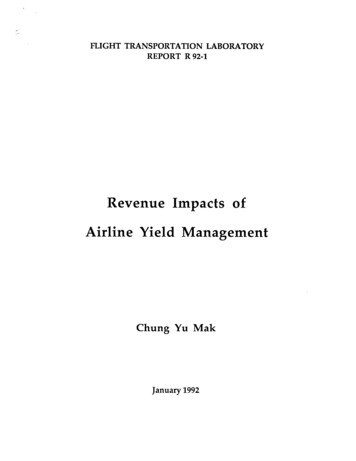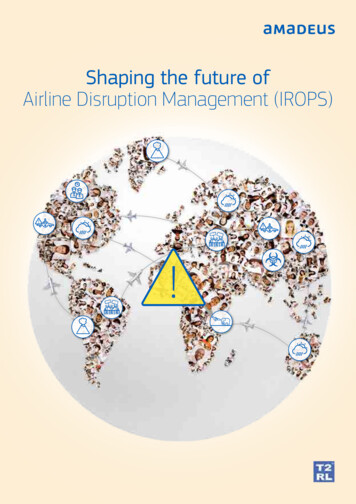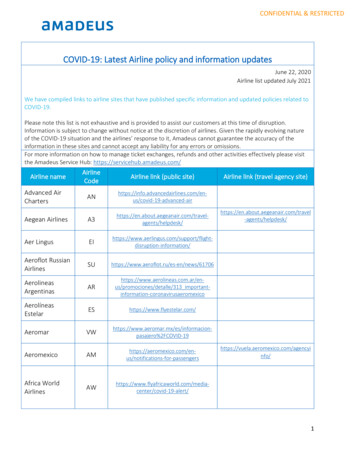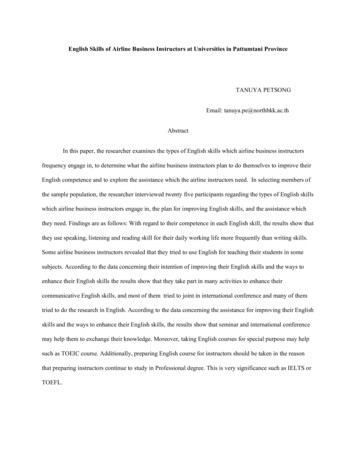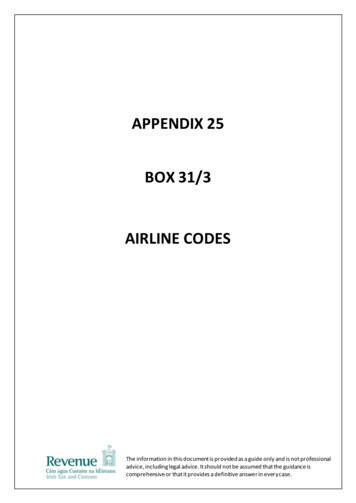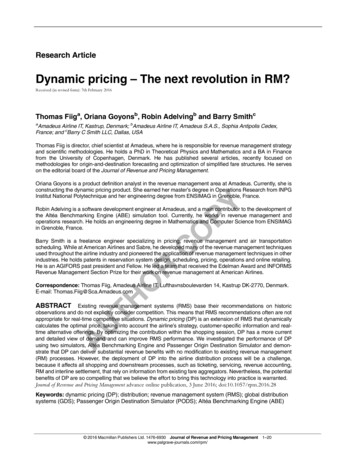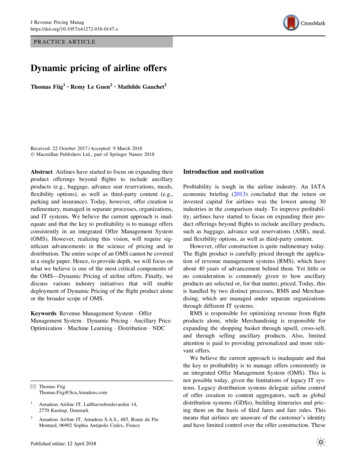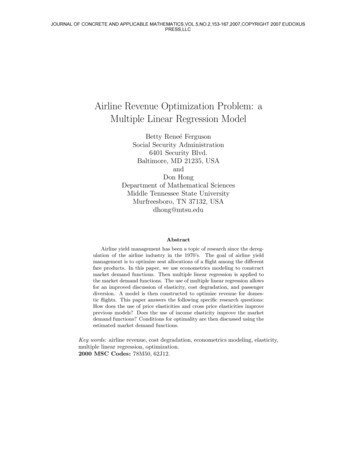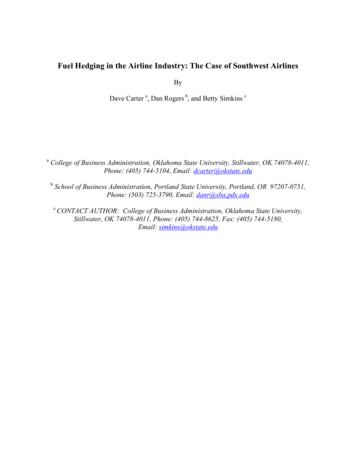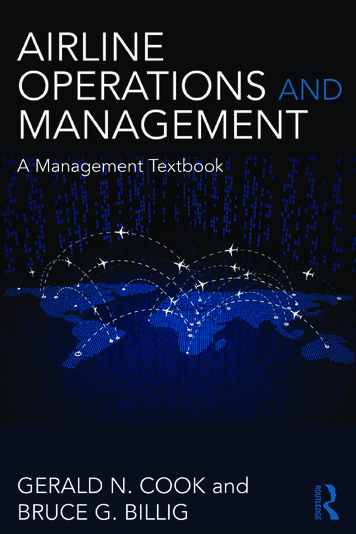
Transcription
Airline Operations and ManagementAirline Operations and Management: A Management Textbook is a survey of theairline industry, mostly from a managerial perspective. It integrates and applies thefundamentals of several management disciplines, particularly economics, operations,marketing and finance, in developing the overview of the industry. The focus is ontactical, rather than strategic, management that is specialized or unique to the airlineindustry.The primary audiences for this textbook are both senior and graduate studentsof airline management, but it should also be useful to entry and junior level airlinemanagers and professionals seeking to expand their knowledge of the industry beyondtheir own functional area.Gerald N. Cook is Adjunct Professor in the College of Business at Embry-RiddleAeronautical University. He obtained his Bachelor of Science in professional pilottechnology and Master of Science in Management from Purdue University andDoctor of Business Administration from Nova Southeastern University. He enjoyed along airline career as a pilot and in various flight operations management positions atseveral airlines. Dr. Cook is retired from Spirit Airlines.Bruce G. Billig is Adjunct Assistant Professor in the College of Aeronautics at EmbryRiddle Aeronautical University. He holds a Bachelor of Science in electrical engineering from the U.S. Air Force Academy and a Master of Aeronautical Science degreefrom Embry-Riddle. He retired from the Air Force as a Command Pilot in 1997 andis currently a captain at Southwest Airlines.
This page intentionally left blank
Airline Operations andManagementA Management TextbookGerald N. Cook and Bruce G. Billig
First published 2017by Routledge2 Park Square, Milton Park, Abingdon, Oxon OX14 4RNand by Routledge711 Third Avenue, New York, NY 10017Routledge is an imprint of the Taylor & Francis Group, an informa business 2017 Gerald N. Cook and Bruce G. BilligThe right of Gerald N. Cook and Bruce G. Billig to be identified asauthors of this work has been asserted by them in accordance withsections 77 and 78 of the Copyright, Designs and Patents Act 1988.All rights reserved. No part of this book may be reprinted or reproduced or utilised in any form or by any electronic, mechanical,or other means, now known or hereafter invented, includingphotocopying and recording, or in any information storage orretrieval system, without permission in writing from the publishers.Trademark notice: Product or corporate names may be trademarksor registered trademarks, and are used only for identification andexplanation without intent to infringe.British Library Cataloguing in Publication DataA catalogue record for this book is available from the British LibraryLibrary of Congress Cataloging in Publication DataNames: Cook, Gerald N., author. Billig, Bruce G., author.Title: Airline operations and management: a management textbook /Gerald N. Cook and Bruce G. Billig.Description: Abingdon, Oxon; New York, NY: Routledge, 2017. Includes bibliographical references and index.Identifiers: LCCN 2016038017 ISBN 9781138237520 (hardback) ISBN 9781138237537 (pbk.) ISBN 9781315299594 (ebook)Subjects: LCSH: Airlines–Management.Classification: LCC HE9780 .C59 2017 DDC 387.7068–dc23LC record available at https://lccn.loc.gov/2016038017ISBN: 978-1-138-23752-0 (hbk)ISBN: 978-1-138-23753-7 (pbk)ISBN: 978-1-315-29959-4 (ebk)Typeset in Galliardby Deanta Global Publishing Services, Chennai, India
To our wives for encouragement, perseverance,research, and initial editing.
This page intentionally left blank
ContentsList of FiguresList of Tables1xivxviiiIntroduction: Goal of Airline Management and OperationsIntroduction 11Historical Perspective31.1 Transportation and Commerce 31.2 First Airlines 41.3 Early Regulation 51.4 History of British Airways 61.5 U.S. Airmail 61.6 Economic Regulation 121.7 Civil Aeronautics Board Economic Regulation1938 to 1978 131.8 Advances in Aircraft Technology 141.9 Post-War Airline Growth 161.10 The Jet Age 181.11 U.S. Deregulation 211.12 The Airline Deregulation Act of 1978 241.13 Post-Deregulation Evolution 241.14 U.S. Deregulation Results 251.15 CAB in Retrospect 261.16 Deregulation in Europe 281.17 Deregulation in China 291.18 Airline Industry Today 301.19 Summary 32References 32Review Questions 33
viiiContents2Supply and Demand for Air Transportation362.1 Size, Scope, and Economic Importance 362.2 Factors Driving Global Air Transportation Growth 382.2.1 Globalization 382.2.2 Demographics 392.2.3 Liberalization 412.2.4 Factors of Production 422.3 Air Cargo 432.4 Forecasting Air Travel Demand 442.4.1 Macro-Forecasting 442.4.2 Route-Level Micro-Forecasting 462.4.3 Passenger Segmentation 472.4.4 Variation in Demand 482.5 Demand Curve 502.6 Need for Forecasts 542.7 New Route Example 542.8 Summary 58Notes 58References 59Review Questions 593Route Structure3.1 History 613.2 Generic Route Structures 623.3 Point-to-Point 623.3.1 Fast, Cheap, and Independent 633.3.2 Limited to Large Markets 633.3.3 Example: Ryanair 633.4 Linear 643.5 Hub-and-Spoke 653.5.1 Operation 663.5.2 Advantages 673.5.3 Disadvantages 713.5.4 Bottom Line 733.5.5 Examples of H&S Route Systems 743.6 Hub-and-Spoke Variations 763.6.1 Hybrid Route Systems 763.6.2 Multiple Hubs 783.6.3 Directional Hub 793.6.4 Rolling Hub 823.6.5 Tailored Complexes 843.6.6 Legal, Financial, and Capacity Restrictions 8461
Contentsix3.7 Hub Airport Requisites 853.7.1 Competing H&S Systems 863.7.2 Hub Failures 863.8 Evolving Route Systems 883.8.1 Southwest Airlines Route System 883.8.2 Delta’s LaGuardia Hub 903.9 Summary 90Note 92References 92Review Questions 934Product Offering4.1 Strategic Choices 954.1.1 The Marketing Concept 954.1.2 Generic Strategies 974.1.3 Industry Evaluation: Porter’s Five Forces 984.2 Comprehensive Network Carriers 1024.2.1 Differentiation 1034.2.2 Delta Air Lines 1054.3 Regional Airlines 1054.3.1 Fleet 1074.3.2 Regional Airlines Worldwide 1104.3.3 Upheaval 1104.4 Low-Cost Carriers 1124.4.1 Business Model 1134.4.2 Ancillary Revenues 1134.4.3 LCC Examples 1154.4.4 Long-Haul LCCs 1164.4.5 LCC within Comprehensive Network Carriers 1174.5 Hybrid Airlines 1184.5.1 Alaska, JetBlue Airways, and Air Berlin 1194.6 Focus Carriers and Tailored Products 1204.6.1 All Inclusive Charter Airlines 1214.6.2 All-Business-Class Service 1214.6.3 Tailored Products 1224.7 Cargo Airlines 1234.7.1 Combination Carriers 1244.7.2 Integrated Carriers 1244.7.3 All-Cargo Airlines 1244.8 Summary 125Notes 127References 127Review Questions 12995
x5ContentsFlight Schedule Development and Control1305.1 Airline Planning Process 1305.2 Strategic Planning 1315.2.1 Long-Range Plan/Fleet Selection 1315.2.2 Product Planning 1325.3 Flight Schedule Development 1335.3.1 Objectives 1355.3.2 Fleet Assignment 1385.3.3 Trade-offs 1385.3.4 Optimization 1395.3.5 The Passenger Service System 1405.4 Asset Assignment 1405.4.1 Aircraft Assignment 1415.4.2 Aircraft Flow Chart 1435.4.3 Crew Pairings and Bid Lines 1435.5 Tactical Management 1475.5.1 Airline Operations Control Center 1475.5.2 Flight Schedule Disruptions 1505.5.3 Managing Irregular Operations 1505.5.4 Irregular Operations Examples 1525.5.5 Dynamic Scheduling 1545.6 Continuous Improvement 1555.6.1 Goals 1555.6.2 Measurement 1565.6.3 Performance Diagnosis 1585.6.4 Corrective Action 1615.7 Summary 161References 161Review Questions 1626Economics and Finance6.1 Profit History 1646.1.1 Cyclical World Airline Profits 1646.1.2 Net Profit Margin 1656.1.3 Profits by World Region 1666.1.4 Return on Invested Capital 1686.2 Earning Profits 1696.3 Revenue Generation 1726.3.1 Yield History 1726.3.2 Fare History 173164
Contentsxi6.3.3 Revenue Passenger Miles 1746.3.4 Ancillary Revenue 1776.4 Cost Structure 1826.4.1 Labor 1836.4.2 Fuel 1866.4.3 Ownership and Rental Expenses 1896.4.4 Taxes 1916.5 Legacy Carrier Restructuring 1946.6 Fleet Selection 1966.6.1 Range and Payload 1976.6.2 Aircraft Operating Costs 1986.7 Fleet Financing 2026.7.1 Internal Financing 2026.7.2 Debt Financing 2036.7.3 Leasing 2046.7.4 Financing Portfolio 2066.8 Economics of Scale, Scope, and Density 2066.8.1 Scale 2066.8.2 Density 2076.8.3 Scope 2076.9 Summary 207Note 208References 208Review Questions 2117Pricing and Revenue Management7.1 Regulated Prices 2127.2 Objective of Revenue Management 2137.3 Revenue Management Components 2147.3.1 Overbooking 2157.3.2 Overselling 2167.4 Pricing 2197.5 Revenue Management Product Characteristics 2207.5.1 Seat Allocation 2217.5.2 Price Discrimination 2247.5.3 Market Segmentation 2257.5.4 Estimating Demand 2277.5.5 Fare Buckets and Fare Nesting 2327.5.6 Expected Booking Updating 2347.5.7 Selling-Up 2367.5.8 Revenue Enhancement with Revenue Management 236212
xiiContents7.6 Network Allocation 2377.6.1 Hidden City Ticketing 2407.7 Revenue Management in Air Freight 2417.8 The Future of Revenue Management 2427.9 Summary 242Notes 243References 243Review Questions 2458Distribution8.1 Airline Distribution History 2478.1.1 The OAG 2488.1.2 Payment 2498.1.3 Ticketing 2508.1.4 The Growth of Travel Agencies 2518.1.5 The Reservisor 2528.1.6 The Magnetronic Reservisor 2548.1.7 Reserwriter 2568.1.8 SABER 2568.1.9 Travel Agents Get Involved 2588.2 The Birth of the Global Distribution System 2608.2.1 CRS Favoritism 2628.2.2 GDS Regulation 2638.3 GDS Mergers, Consolidation, and Sell-Off 2668.3.1 European Connections 2678.3.2 Deregulation 2688.4 The Rise of the Internet Changes the GDS Environment 2708.4.1 Airline Internal Reservations Systems 2728.4.2 Shift in Travel Agency Approach 2728.5 The Rise of Online Travel Agencies 2738.5.1 Standard Online Travel Services 2748.5.2 Opaque Travel Services 2768.5.3 Fare Aggregators and Metasearch Engines 2778.5.4 Travel Agents Using GDS Alternatives 2788.6 New Distribution Capability 2798.6.1 Airline Perspective 2818.6.2 GDS Perspective 2818.7 Summary 282Note 283References 283Review Questions 287246
Contents xiii9International Air Transportation and Public Policy2889.1 Air Service Agreements 2889.1.1 US Open Skies 2909.1.2 EU Open Skies 2939.1.3 Air Service Liberalization Support and Opposition 2949.2 State-Owned Airlines 2949.3 Global Alliances 2989.3.1 History of the Big 3 Global Airline Alliances 2989.3.2 Marketing and Revenue Benefits 3019.3.3 Operating Benefits 3019.3.4 Antitrust Immunity 3029.3.5 Establishing an Alliance 3029.3.6 Passenger Benefits 3049.3.7 Alliance Instability 3049.3.8 Equity Alliance 3059.4 Consolidation—Mergers and Acquisitions 3069.5 Summary 307Note 308References 308Review Questions 30910 Looking Ahead31010.1 Cyclical Profits 31010.1.1 Fixed Cost 31110.1.2 Fuel Expenses 31110.1.3 Cost Control 31210.1.4 Airline Failure and Restructuring 31210.2 Environmental Regulation and Cost 31210.3 Turmoil in Distribution 31310.4 Complex Airline Structures 31410.5 Governance 31510.6 Evolving Airline Strategies 31610.6.1 Business Model Evolution 31610.6.2 Emerging Models 31810.7 Still Fragmented 319References 319GlossaryIndex321338
Figures1.1 Early Airlines. (a) Imperial Airways Route System and (b) HandleyPage H.P. 421.2 (a) Waco JTO Taperwing and (b) Boeing B-40Waco photo courtesy of Embry-Riddle Aeronautical UniversityArchives. B-40 from Wikimedia Commons1.3 Contract Airmail Routes (CAMs), circa 19301.4 The Ford Tri-Motor1.5 Douglas DC-31.6 Large Piston-Powered Aircraft. (a) Douglas DC-6 and(b) Lockheed Super Constellation1.7 (a) Boeing 707 Operated by British Overseas Airways Corporationand (b) a Pan American World Airways Boeing 7471.8 (a) Airbus A300 operated by launch customer Air France and(b) Singapore Airlines flagship A380. A300 photo courtesy ofAirbus. A-380 photo from Wikimedia2.1 World Air Traffic 1974 to 2034. Traffic is measured in trillionsof revenue passenger kilometers (RPK). One RPK represents onepassenger flying one kilometer in air transportation. In the U.S.,the more common statistic is the revenue passenger mile (RPM).Figure courtesy of Airbus, 20152.2 Air Travel and Per Capita Income. Figure courtesy of Airbus, 20152.3 Annual Air Traffic Growth. Figure courtesy of Airbus, 20152.4 Growth in U.S. Scheduled Revenue Passenger Miles2.5 Air Cargo Growth. Figure courtesy of Boeing, 20122.6 Air Travel and GDP. Figure courtesy of Boeing, 20142.7 Airbus A-380. Photo courtesy of Airbus2.8 Demand for Air Travel2.9 The Southwest Effect2.10 New Route Evaluation. June 2016 route map courtesy ofVirgin America2.11 S-Curve3.1 Generic Route Systems79101115171921384041424345465051555662
Figures3.2 Ryanair’s Stockholm Base Routes3.3 Linear Routes in Southwest Airlines’ Network.(b) from MIT/ICAT (used by permission)3.4 Flight Segments Required3.5 Examples of Hub-and-Spoke Systems. Etihad June 2016 routemap courtesy of Etihad Airways3.6 JetBlue Route Systems3.7 Delta Air Lines Multiple Hubs3.8 Directional Hub-and-Spoke Systems3.9 Effect of Rolling Hub at Dallas-Ft Worth3.10 Competing Hub-and-Spoke Systems3.11 Southwest Airlines Chicago Midway Route System4.1 Passenger Criteria in Airline Choice4.2 Evaluating Industry Competition4.3 Airline Product Design. Adapted from Holloway, 20024.4 Air Canada’s fare options. Reproduced with the permissionof Air Canada4.5 Regional Airline Passenger Miles Growth4.6 Embraer 145 and 1954.7 SkyWest Route System as of June, 2016.Courtesy of SkyWest Airlines4.8 Growth of Low-Cost Carriers5.1 Airline Planning Process5.2 Alitalia Timetable5.3 Flight Schedule Objectives5.4 Aircraft Assignment5.5 Aircraft Flow Chart5.6 Flow Chart, Pairings, Bid Lines5.7 Airline Operations Control Center5.8 Irregular Operations5.9 Control Process5.10 Operational Metrics. Panel A—Percentage of flightsarriving on time for the 12 months ended March 2016.Panel B—Passenger complaints per 100,000 enplanementsfor the 3 months ended March 20165.11 Southwest Airlines Operational Performance5.12 Operational Performance Summary6.1 World Airline Net Profits. Profits are adjusted for inflationand measured in 2014 dollars6.2 2015 Pre-Tax Profit Margins Comparison for U.S. Airlines6.3 Airline Earnings Vs. Other Aviation Sectors 1996 through 20046.4 Earnings Before Interest and Tax for 2012, 2013, 2014 and 2015(forecast). Data exclude bankruptcy reorganization and other largenon-cash expenses that substantially impacted US airline 2131134135142144146148153156157159160165166167167
87.97.107.117.127.137.147.157.167.177.18Return on Capital 2000 through 2014World Airline Nominal and Real Yield, 1959–2014World Airline Capacity 1969 to 2014World and U.S. Airline Load Factor from 1960 through 2014Breakeven Load Factors for U.S. Airlines from 1971 to 2015Worldwide Ancillary Revenue Growth from 2007 through 2014Key Ancillary Revenue Components of U.S. Airlines in 2013Ancillary Revenue as a Percent of Total RevenueSpirit Airlines Carry-On Bag RulesU.S. Airline Administrative Cost Percentages for the 1st Quarterof 2015U.S. Airline ASM Versus Full-Time Equivalent EmployeesLabor Productivity in the U.S. as Measured by ASM Per Full TimeEquivalent (FTE) EmployeeHistorical Jet Fuel PricesUnit Operating Costs from 2007 through 2014Percentage of Ticket Prices Going to TaxesFY 2015 Airline Tax CollectionCASM Versus Segment LengthAircraft Fuel Efficiency ImprovementsCheck-In Kiosk Screenshot.No Overbooking RevenueRevenue with OverbookingOverbooking ExamplesDemand Curve Indicating One Unit Sold at Price P1.Total Revenue is P1 U1, Equal to the Shaded AreaDemand Curve Indicating Four Units Sold at Price P4.The Total Revenue for Selling Four Units Is P4 U4 andEqual to the Shaded AreaDemand Curve Showing Four Units Sold, One Unit atEach Price P1, P2, P3 and P4. The Total Revenue isIndicated by the Total of the Four Shaded AreasMarginal CostHistorical Reservation Data from a Specific Flight for the 600 B FareProbability Density Function for 600 B FareSurvivor Function for 600 B FareExpected Marginal Seat Revenue Plot for the 600 B FareExpected Marginal Seat Revenue Plot for the 500 M FareExpected Marginal Seat Revenue Plot for the 300 Q FareExpected Marginal Seat Revenue Plot for the 800 Y FareEMSR plots for Four Fares in a 100-Seat AircraftFare NestingTypical Airline Online Reservations Web 231232233234
FiguresxviiExpected Booking CurveNetwork Allocation ExampleOrigination/Destination Revenue ManagementDemand-Driven Fares, from EmiratesEarly Reservations Center at Pan AmOctober 1954 OAG Cover and Sample PageTicket Blanks.Hand-Written Ticket from 1952Automated TicketAn Early Reservisor TerminalThe Magnetronic Reservisor Desk-Set (left) in Use at a ReservationsOffice and Drum Storage Units (right)8.8 Schematic Diagram Showing Elements in a Typical TeleregisterMagnetronic Reservisor System8.9 Sabre Advertisement.8.10 Typical Sabre GDS Screen Display8.11 U.S. CRS Market Share in 19888.12 Major GDS Pedigree Chart with Current Subsidiaries andJoint Ventures8.13 EDIFACT Screen Presentation8.14 NDC Screen Presentation8.15 Airline Distribution Diagram9.1 Ryanair’s Proposed EU–US Service Under Open Skies9.2 Private versus State-Owned Airlines9.3 Northwest/KLM Alliance9.4 Continuum of Alliance Cooperation9.5 Etihad Airways Equity Alliance10.1 World Airline Profits and Global Gross Domestic 2292295299303306311
28.39.19.2Airline Industry Size and Scope for 2013Factors Causing a Change in DemandA Comparison of Hub-and-Spoke and Point-to-Point SystemsSpirit Airlines Ancillary FeesFading Distinction between CNC and LCCWorld’s Top 25 Airlines2013 Attempted Fare IncreasesFuel Productivity (ASM per gallon) for Selected Airlines for 2010Taxes and Fees for a Hypothetical Domestic Flight fromPeoria, IL, through Chicago O’Hare, to Raleigh-Durham, NCLCC Versus Comprehensive Network Carrier CostsCommercial Aircraft Leasing CompaniesAircraft Financing OptionsRevenue Management ExampleTravel Agency Locations, Sales and Commission Rates1984 GDS Market Shares1988 Market ShareElements of US/Netherlands Open Skies ASAGlobal Airline 7267291300
IntroductionGoal of Airline Management and OperationsThis textbook is a survey of the airline industry from a managerial perspective.The primary audience is senior and graduate students of airline management,but it should also be useful for entry and junior level airline managers needing abroad knowledge of the industry extending beyond their own functional area. Abackground in the various management disciplines typically covered in an undergraduate degree program in business or management is helpful, but not essential.The text applies and integrates the fundamentals of several management disciplines, particularly, economics, operations, marketing, and finance in developingthe overview of the industry. The focus is on tactical, rather than strategic, management that is specialized or unique to the airline industry. Human Resourcemanagement, for example, is not addressed, not because it isn’t crucial to an airline’s success, but because the skills required are not unique to the industry. Themanager with a broad understanding of the industry and its competitive environment is better equipped to work in interdisciplinary assignments and, ultimately,to succeed and progress in an airline career. This is the goal of this text.June 2016IntroductionThe dynamic and rapidly expanding airline industry is essential to the functionof the world economy and for continued economic growth. It’s also an industryoften in turmoil, sometimes as a result of myopic management focus on marketshare but more often due to economic crises beyond the control of airline executives. The first decade of the twenty-first century was especially cruel to the industry as it endured two severe economic recessions, the so-called Great Recessionbeginning in 2008 being the most devastating since the Great Depression ofthe 1930s. As a direct result of falling demand, several airlines failed includingATA, Maxjet, Aloha, Sterling, and Oasis. Others were forced to pare routes andfrequencies and reduce costs in restructuring that continues today. This bookexamines the history, structure, and functions of the airline industry from amanagement perspective with the goal of providing students and junior managers with a broad overview of airline operations and management. Although the
2Introductiontools of several management disciplines are employed, previous study of businessadministration is not required.The text begins with a summary of airline history from the emergence of theearliest passenger airlines immediately following the end of World War I to thepresent. Chapter 1 emphasizes the role of government economic regulation,ownership, and subsidies in the development of the early industry. Rapid technological progress, especially in aircraft speed, reliability, and comfort, increaseddemand and lowered costs to the point that government policy makers, beginning in the United States, freed airlines from regulation of routes and fares leading to an increasingly free market in much of the developed world.Chapter 2 turns to the forces that drive airline demand and supply and therapid growth in airline passenger and cargo transportation which is now mostevident in Asia. Airline product offerings are the subject of the next two chaptersbeginning with an airline’s choice of route structure to connect the destinationsit has chosen to serve. An airline has a range of product amenities it can providewith its core transportation product from the Spartan service characteristic oflow-cost-airlines to a choice of amenities from first class to economy coach provided by most of the world’s largest airlines. The first half of the book ends byexploring the process of developing and managing a flight schedule.Airline economics and finance are addressed in Chapter 6 with a focus on thelargest categories of airline expense and management’s options for cost controlin the face of increasing competition. Fleet renewal, expansion, and financing concludes the chapter. The complex and frequently misunderstood process of airline pricing is the subject of Chapter 7. Sophisticated airline revenue management systems employed by most airlines attempt to maximize revenue by charging different prices to different passenger segments based on willingness andability to pay for air travel.Distribution of airline product information and tickets initially borrowed longestablished practices from the railroad industry. However, faced with rapid passenger growth and product complexity, the first widespread use of computerizedsystems for distribution developed in the airline industry to automate early, laborintensive manual methods to book and track airline passengers. More recentlythe Internet has enabled passengers to easily compare airline products and faresleading to more price competition.The text concludes by considering the early regulation and subsequent liberalization of international air commerce, the concurrent privatization of manystate-owned airlines, and the emergence of the big three global airline alliances.
Chapter 1Historical PerspectiveSeveral scheduled passenger airlines emerged in Europe shortly after the end ofWorld War I in 1918. Economic regulation of routes and prices followed shortlythereafter and prevailed for much of the 20th century. Late in the century, thederegulation of the U.S. airline industry began a trend followed by the EuropeanUnion and then by much of the rest of the world. This history provides a foundation for understanding today’s complex, competitive, and global airline industry. This chapter traces the industry from the era of economic regulation tothe increasingly free market competition allowed in most of the world’s largest markets. After outlining the growth of the early airlines in Europe, the focusshifts to the United States, beginning in 1918 with airmail operated by the U.S.Post Office. Using this early airmail endeavor as our starting point, the chapter traces the fledgling industry through the years of economic regulation underthe Civil Aeronautics Board until economic deregulation in 1978, emphasizing the economic, regulatory, and technical evolution that shaped the industry.This historical perspective then continues with post-deregulation developments,including the emergence of low-cost carriers, bankruptcies, mergers, and buyouts. Airline deregulation next occurred in Europe, and then spread to severalother world regions. To gain a broader perspective on the deregulation processand outcome, the U.S. experience is compared with that of Europe and China,leading to the conclusion that competitive results are remarkably similar. A shortcharacterization of the industry concludes the chapter.1.1 Transportation and CommerceAir transportation is just one element of the world’s transportation infrastructure,which is essential for economic growth and prosperity. Sailing ships have tradedbetween countries for at least two millennia, making those cities and states thatcontrolled trade wealthy. The past riches of Venice, still evident today in magnificent buildings, were based on trade. Today, ever larger and more efficient container ships reduce the cost of ocean shipping, facilitating the huge trade betweenChina, Europe, and the Americas.Rivers were the first and most efficient means for inland transportation ofgoods and people. The construction of canals to improve and supplement natural
4Historical Perspectivewaterways dates back to at least the 6th century bc, when a canal linked theNile River with the Red Sea. Extensive waterway building in China began inthe 3rd century bc. The famous Venetian canals were extensions of the naturalwaterways among the islands on which Venice is built, and date from the founding of the city in the 5th century. Elsewhere in Europe, the Netherlands begancanal construction to foster economic development in the 12th century, withconstruction then spreading across much of Europe. The British canal systemplayed an important role in the Industrial Revolution, beginning in the 18th century. In contrast, economic development in Africa has been stunted by the lackof navigable rivers to facilitate commerce. Waterway construction in the UnitedStates is more recent, with the building of the Erie Canal connecting the HudsonRiver in New York with Lake Erie and the other Great Lakes not completed until1825. The alternatives to waterway transportation at that time, usually by horseand wagon train, were comparatively much more expensive, slower, and limited.Railroads, first introduced in Great Britain in the early 19th century, graduallysupplanted canals, offering higher speed over a much larger geographical area.Transportation systems have often been financed and built by private firms,but market forces are generally insufficient to provide for the vast transportationinfrastructure necessary to foster widespread economic growth. Therefore, governments frequently plan, build or subsidize, and regulate transportation systems.In the United States, for example, the federal government encouraged andsubsidized the development of both water and rail transportation. Railroads wereoften joint ventures of federal and state governments and private firms. The greatwestern expansion of railroads following the Civil War, most notably the completion of the transcontinental railroad in 1869, allowed farm products from theMidwest to reach the heavily populated East Coast cities beginning in the early1870s. Midwest farmers, in turn, were able to readily purchase goods from EastCoast manufacturers, which vastly improved their standard of living. The GreatPlains was transformed from a wasteland to a breadbasket. Transportation enablestrade, which improves the overall standard of living.The federal government remains essential in supporting transportation systems, including highways and roads, waterways, railways, pipelines, airways, andairports. The Army Corps of Engineers still operates the series of locks on theMississippi and Ohio rivers over which Midwest grains are transported for exportworldwide. Likewise, governments have also played a critical role in the development of commercial aviation. The Middle Eastern countries, especially theUnited Arab Emirates and Qatar, have recently invested heavily in airports andstate-owned airlines to promote economic growth and diversity from dependenceon petroleum exports.1.2 First AirlinesEnabled by the rapid wartime advances in aircraft technology and a post-war surplus of aircraft, airlines were founded in the immediate aftermath of World War I in
Historical Perspective51918. While there were a few earlier, short-lived ventures, many current Europeanairlines trace their origins to the immediate post-war era. KLM claims the distinction of being the oldest carrier still in operation, having been founded in 1919.Scheduled flights between London and Amsterdam began in 1920 and continue tothis day (AirFrance/KLM, n.d.). Similarly, the airlines that would later become AirFrance trace their origins to this period. Australia’s Qantas also dates from 1920. Inthe Americas, Colombia’s Avianca is the world’s second oldest airline after KLM.Although Germany lacked the colonial empires of the British, French, and Dutch,it was also home to several early airlines. Today’s Lufthansa is a post-World War IIcreation with some roots dating to 1926. Asia is now the fastest-growing airlinemarket, but its airlines generally trace their origins to the post-World War II era.KLM’s title as the oldest airline in continuous operation notwithstanding, it isBritish A
4.5 Hybrid Airlines 118 4.5.1 Alaska, JetBlue Airways, and Air Berlin 119 4.6 Focus Carriers and Tailored Products 120 4.6.1 All Inclusive Charter Airlines 121 4.6.2 All-Business-Class Service 121 4.6.3 Tailored Products 122 4.7 Cargo Airlines 123 4.7.1 Combination Carriers 124 4.7.2 Integrated Carriers 124 4.7.3 All-Cargo Airlines 124
